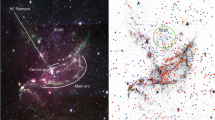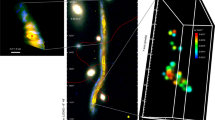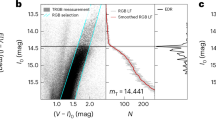Abstract
WITH objective prisms used on a Schmidt telescope, faint late type stars may be identified with a dispersion of 1,700 Å mm−1, at the atmospheric A band, on photographic plates sensitive in the near infrared spectral region. The required spectral classification techniques were developed by J. J. Nassau and various collaborators1–3. These techniques were used by Westerlund4,5 with the Mt Stromolo-Uppsala 50/66-cm Schmidt telescope to survey the M-type supergiants in the Large Magellanic Cloud (LMC). Westerlund found relatively large numbers of early type M stars brighter than mi = 13.0 in the photometric system of Kron, Gascoigne and White6.
This is a preview of subscription content, access via your institution
Access options
Subscribe to this journal
Receive 51 print issues and online access
$199.00 per year
only $3.90 per issue
Buy this article
- Purchase on Springer Link
- Instant access to full article PDF
Prices may be subject to local taxes which are calculated during checkout
Similar content being viewed by others
References
Nassau, J. J., and Van Albada, G. B., Astrophys. J., 109, 391 (1949).
Nassau, J. J., and Cameron, D. M., Astrophys. J., 119, 175 (1954).
Nassau, J. J., and Velghe, A. G., Astrophys. J., 139, 190 (1964).
Westerlund, B. E., Uppsala Ann., 4, 7 (1960).
Westerlund, B. E., The Galaxy and the Magellanic Clouds, IAU-URSI Symposium No. 20, (edit. by Kerr, F. J., and Rogers, A. W.), 239 (Australian Academy of Sciences, Canberra, 1964).
Kron, G. E., Gascoigne, S. C. B., and White, H. S., Astr. J., 62, 205 (1957).
Blanco, V. M., Publs astr. Soc. Pacif., 86, 841 (1974).
Morgan, W. W., Publs Obs. Univ. Mich., 10, 33 (1951).
Keenan, P. C., and Schroeder, L. W., Astrophys. J., 115, 82 (1952).
Gatterer, A., Junkes, J., Salpeter, E. W., and Rosen, B., Molecular Spectra of the Metallic Oxides (Specola Vaticana, 1957).
Treanor, P. J., and McCarthy, M. F., Colloquium on Late Type Stars, (edit. by Hack, M.), 109 (Trieste, 1966).
McCarthy, M. F., Atti delle Celebrazioni del V Centenario della Nascita di N. Copernico, (edit. by Rosino, L., and Barbieri, C.), 87 (Soc. Astr. Ital.ed. Observatorio Astronomico di Padova, Padova, 1973).
Bok, B. J., A Rev. Astr. Astrophys., 4, 95 (1966).
Lucke, P. B., Stellar Associations in the LMC, University Microfilms, Ann Arbor, Michigan, Dissertation no. 73–13, 852, (1974); Astrophys. J. Suppl., 28, 73 (1974).
Blanco, V. M., Astr. J., 69, 730 (1964).
Bowen, I. S., and Vaughan, A. H., Publs astr. Soc. Pacif., 85, 174 (1973).
Author information
Authors and Affiliations
Rights and permissions
About this article
Cite this article
BLANCO, V., MARTIN F. MCCARTHY, S. Late type giants in Large Magellanic Cloud. Nature 258, 407–408 (1975). https://doi.org/10.1038/258407a0
Received:
Accepted:
Issue Date:
DOI: https://doi.org/10.1038/258407a0
This article is cited by
-
Carbon and M-type giant stars in the Magellanic Clouds
Nature (1978)
Comments
By submitting a comment you agree to abide by our Terms and Community Guidelines. If you find something abusive or that does not comply with our terms or guidelines please flag it as inappropriate.



